Scott and Julie explore Marvin's home of many years.

TRIP REPORT: Philipsburg, Montana
Julie’s family reunion in Whitefish, Montana, was a good enough reason to plan a two-day side trip to Philipsburg to walk the streets that Marvin Blonger, “The Enigma,” once trod. I came with low expectations and, I’m embarrassed to say, little preparation. My goal on Monday, our only full day in town, was to check the courthouse and the historical society and see if I could turn up any evidence of Marvin’s nearly 25-year stay in Granite County, home of some heavy prospecting and mining operations in Marvin’s day.
On the way down from Whitefish we made a stop at the Missoula Cemetery to visit the graves of Mary Blonger, Marvin’s wife, and Edward, his son. Mary died in 1897 at age 45 from the effects of an operation. Edward, who was a miner like his father, died in 1917. Marvin moved around some in the 1890s. His daughter Ollie was born in Montana, perhaps in Missoula, in 1891. But an 1899 newspaper report, after Mary’s death, places Marvin in Park City, Utah. By the time of the 1900 census, Marvin had left Park City and placed Ollie in the care of her older sister Abbie, who had married James Kervin. Marvin headed north with Edward, then 15, to Granite, Montana, up the hill from Philipsburg and site of the heaviest silver mining.
All of this would have been good to know when I arrived in Philipsburg, but because I thought we knew next to nothing about Marvin, I failed to bring any notes with me. Fact is, we knew more than I thought we did.
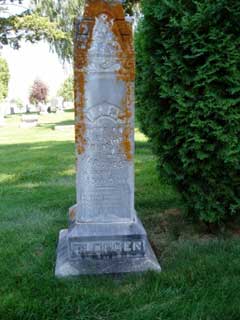
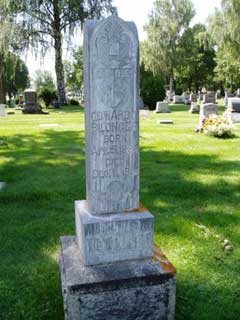
Mary and Edward Blonger’s headstones in Missoula Cemetery.
We pulled into Philipsburg on a bright Sunday afternoon. The town lies on the edge of a three-mile wide valley between the looming Flint Creek Range on the east and the smaller, rolling John Long Mountains on the west. Flint Creek meanders through the meadow in the middle of the valley, but this is no lazy river: the water is moving quickly, dancing its way down to the Clark Fork. Main Street of Philipsburg is wide and welcoming, a little dusty, with many old buildings in various stages of restoration. As we drove toward the center of town, I was immediately struck by the town’s resemblance to Shullsburg, Wisconsin, Marvin’s boyhood home. In both places, the main thoroughfare originates at the highway on the west side of town and climbs to the east. On both sides, the cross-streets rise steeply and buildings on the side streets are easily visible. It’s not a perfect match. Shullsburg has more trees and Phillipsburg is built on the side of a mountain with a terrific vista to the west. But still, as I descended to Main Street, I found myself aching to buy cheese curds at the Shullsburg Cheese Store.
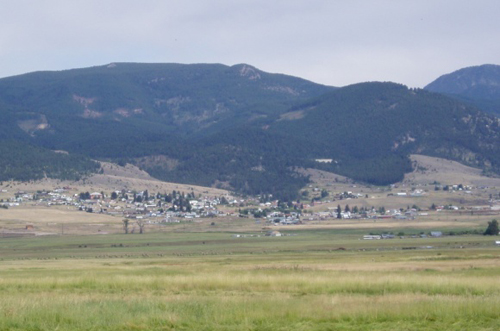
Philipsburg from the northwest. The ghost town of Granite is on the back side of Franklin Hill to the right.
After an overnight at the Quigley Cottage Bed & Breakfast, we started our search at the courthouse, looking for real estate transactions or mining claims. We already knew of one patent, filed in 1904 by the Auraria Mining Company, on two placers and two lodes about six miles from Phillipsburg. Auraria was the name of Sam and Lou Blonger’s mining company in Colorado, and the fact that a company of the same name filed a patent near where brother Marvin was living and working appeared to be more than just a coincidence.
As it turns out, Marvin was no Donald Trump, but he did buy a plot in the town of Philipsburg. on July 27, 1911, for $650. It’s unclear whether the land already contained a house when he bought it, but it surely did when he sold it on January 23, 1925, for $2,000. With the help of a town plat map, our goal of locating the site proved ridiculously easy: Marvin’s house was thirty feet away, right outside the window of the room we were sitting in. Well, not Marvin’s house exactly. The home on the current site is of recent construction. A walk outside revealed two neighboring homes that seemed to be contemporaries of the Blonger house. Our B&B hosts, Dave and Davee Letford, later confirmed that Marvin’s house was torn down only a couple of years ago and replaced by a new two-story model.
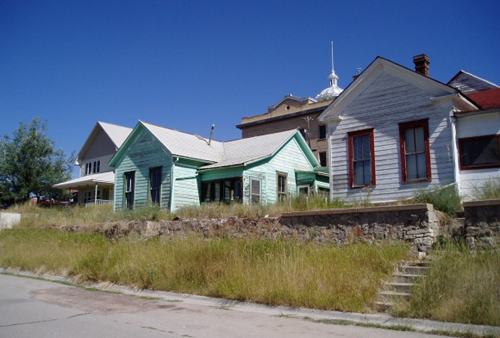
The yellow house at the left now occupies the site of Marvin’s house, which
was similar in construction to the two houses in the foreground.
-marvin's house closeup.jpg)
A view of the courthouse, circa 1920. Marvin’s home is in the center of the photograph.
Further searches in the courthouse records turned up the Auraria transactions. The claim on the Confident lode was filed on October 7, 1896, by Matt Anderson and John Olson for the Auraria Mining Company. The patent for the four parcels (Confident lode, Julee lode, Castle placer, and Placer No. 1 placer), filed on November 19, 1904, indicates that claims for all four were made on December 31, 1902, but I did not find this document. All four patents were sold at a tax auction in 1913, ending Auraria’s brief history as a Granite County land owner. I found no evidence that the Blongers had anything to do with this Auraria, which was disappointing. The case is still open, but the fact that Lou and Sam Blonger were prominently named on the Colorado patent, and not in Montana, makes me think this could simply be a case of a company with the same name.
While the courthouse rolls revealed that Auraria was a likely red herring, they also dangled an enticing new lead. On August 18, 1909, Marvin Blonger filed a claim on two lodes, the Deer and the Bear, in the Granite district. According to the documents, Marvin had made discovery cuts on both claims. At the courthouse I was unable to find a location map of the claims in the Granite district, but once again our hosts came to the rescue. Davee Letford is a real estate agent who has helped buy and sell many of these claims. Her map showed that the two claims were adjacent parcels at the southern part of the Granite district, in the hollow of Douglas Creek. Marvin held on to these claims until October 4, 1917, when he sold them the Bi-Metallic Mining Company for the sum of $1. Why Marvin never patented the claims and why he turned them over to Bi-Metallic for a song are huge questions that need to be investigated. Bi-Metallic turned around and filed the patents, establishing ownership of the land, on November 1, 1918 (for the Deer) and June 20, 1919 (for the Bear). Both parcels are currently owned by a company called Cottage, Inc.
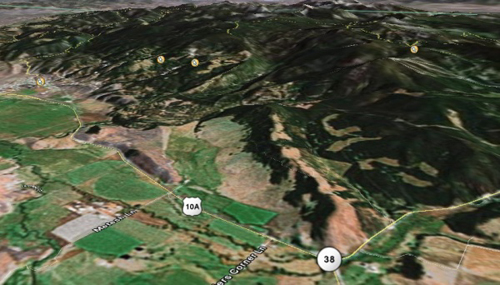
Aerial view of Philipsburg area, looking northeast. The pushpins represent, from left to right: (1) Marvin’s house in Philipsburg, (2) Granite town site on Franklin Hill, (3) Marvin Blonger’s claims along Douglas Creek, (4) Auraria Mining Company’s claims along the North Fork of Flint Creek. (Image from Google Earth)
It was time to search for Marvin’s land. Our trip to the ghost town of Granite was a bumpy ride up a narrow, rutted, dusty road that hugged the south side of Franklin Hill. At certain points, the canopy of pine trees broke away to reveal a dizzying view of the valley below. Near the top of the mountain we began to see remnants of the town that once held 3,000 miners. Marvin lived here in 1900 and 1910, perhaps until he bought his plot in Phillipsburg in 1911. Now all that is left are scores of dilapidated structures, mostly reduced to piles of rotting lumber, along with some more modern structures that indicated some minimal mining was probably still taking place. Marvin’s claims, the Bear and the Deer, were about a half a mile down the hill from the Granite town site, perhaps 400 feet lower in elevation. There was no time for a hike through the forest and brush, but I was able to get a sense of what the land was like and what Marvin must have gone through to establish his claim. No doubt it was tough getting to and from his land and digging in the rocky earth. On a return trip I might be tempted to reach the claim by ascending along Douglas Creek rather than tracking down from the Granite town site. I suspect we will be able to find evidence of mining operations, perhaps including the discovery cuts that were shown on the mining plat map.
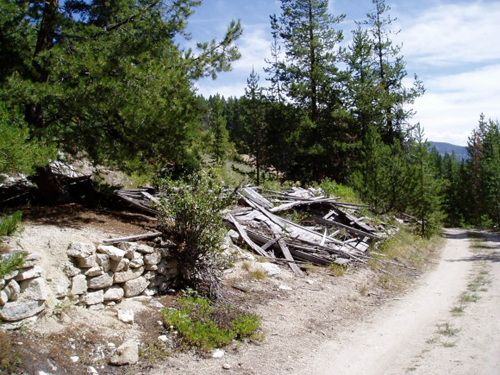
Ruins in the ghost town of Granite, Montana.
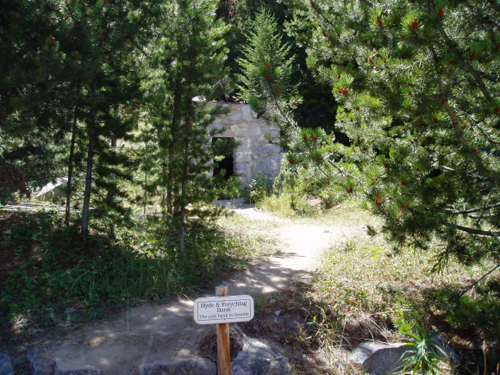
The old bank vault is one of many crumbled relics in Granite.
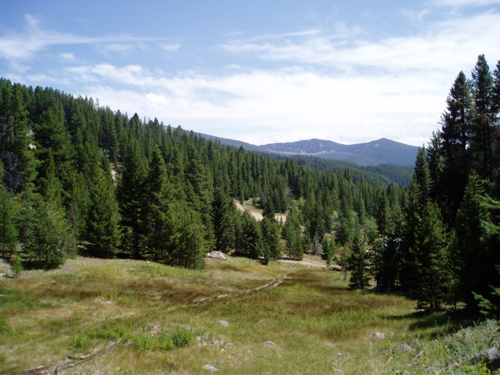
Looking toward Marvin’s claims, a half-mile out and some 400 feet below this spot.
I set out on my own to find the Auraria claims on the North Fork of Flint Creek. Though only about four miles away by air, reaching the site by car required a circuitous trip of about 25 miles up into the hills past Georgetown Lake and the Discovery Ski Resort. A right turn near the resort put me on an arrow-straight gravel road that ascended slowly but surely through a forest of lodgepole pine. Through the topographic map showed the creek paralleling the road, the stand of trees effectively hid the water and the ridges that rose on either side. Not until I reached my destination, about four miles up the road, did the forest yield to the rest of the scenery. There, a road broke off to the left, down a small hill, over a culvert containing the small creek, and into an excavated area. A sign warned that blasting was taking place here. The operation was actually a little beyond where the Auraria claims were located, but as far as I could tell, the Auraria land was simply rocky forest ground. I did not investigate Red Lion, a small ghost town a little further down the road.
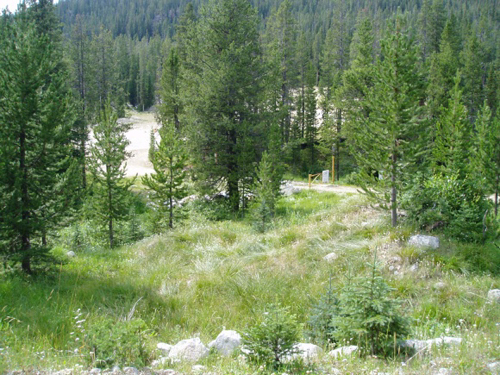
Active mining operation near the site of the Auraria claims.
The creek crosses the road in a culvert near the gate.
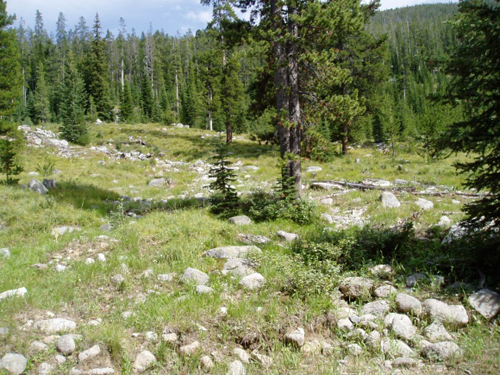
The rocky ground of the Auraria claims.
Back at the Quigley B&B, we recounted our experiences. Dave Letford had promised to ask an old-timer about Marvin Blonger, but I didn’t expect any useful information. According to his obituary in 1927, Marvin left Philipsburg about three years before his death to live with his daughters, first in San Francisco and later in Dunsmuir, California. That anyone still living would remember a man who left town 80-some years ago was really too much to hope for. But in small towns people have long memories, and it seems the Blonger name made an impression wherever it happened to appear. Dave asked if I wanted to see where Marvin worked, so we took a ride in his ATV to the edge of town to the ruins of the Philipsburg Mining Company, where the old-timer, Roy, remembered that Marvin was the superintendent. That seemed a possible fit with the census records, which showed that in 1900 Marvin was a “boss in mine” and in 1920 was a foreman in a silver mine. By 1920 Marvin was 69 years old, ancient for a miner, a little old to be named superintendent, but then, who was to say?
As we inspected the broken foundation and timbers, Dave hit me with a surprise. Roy hadn’t wanted him to mention this at first, but the rumor was that when the Philipsburg Mining Company burned down in the 1920s, Marvin lit the match.
Well, I thought, even if it isn’t true, at least Marvin now had an identity. “The Enigma” has become “the (Reputed) Firebug.”
A little research back home revealed that the plant burned down on February 19, 1925, putting the company out of business. Marvin had sold his house four weeks before. Did he leave immediately for California, or did he stick around long enough to lay the torch to his former workplace? Would a 74-year-old man, perhaps in ill health, soon to leave town, really turn to arson to settle an old score? Or could it have been the notoriety of the Blonger name, given Lou’s recent arrest, trial, and death, that caused townspeople to suspect Marvin? Perhaps it was just a whisper campaign against a convenient target, an old man and a harsh boss, who happened to pick the wrong moment to move to another state.
Or perhaps, there’s no smoke at all. Here’s what Clyde J. Neu had to say about the fire in A Town Founded on Hope (1996):
In 1921 Ralph S. Blitz was named Superintendent of the Philipsburg Mining Company…. Annually the company suspended operations for about two weeks in January to overhaul and repair the mill. During this closure in 1925, the mill caught fire and was completely destroyed. There was much speculation in town as to whether the fire was intended or an accident. In any event its burning spelled finis to the company’s operations, as they never rebuild the mill. All operations for the present ceased and Blitz left the company on May 22, 1925.
Roy, our informant, had mentioned that Marvin Blonger was the superintendent of the mill. Could he have been remembering Ralph Blitz instead? Blonger…Blitz? Odd-sounding names starting with BL? Whatever the case, Marvin went to California a free man and died there less than three years later. Answers to the mystery may await us in microfilmed copies of the Philipsburg newspaper.
In summary, our brief trip to Philipsburg was interesting and definitely worth a return someday. The Letfords were very knowledgeable about local history and, thankfully, more than willing to help our search. And for a town of 1,000 people nestled in a county of 2,800, Philipsburg offers far more than expected. It is full of historic buildings, including the state’s oldest still-operating jail, school, and theater, all built in 1896. Julie’s a theater buff, so we rolled into town just in time for the Sunday evening performance. That was fun, too, except for the vamp routine where I was corralled onstage with a feather boa around my neck. But that’s Blongermania – a surprise around every bend.
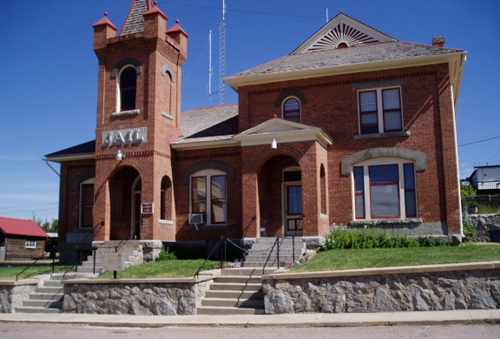
Granite County Jail.
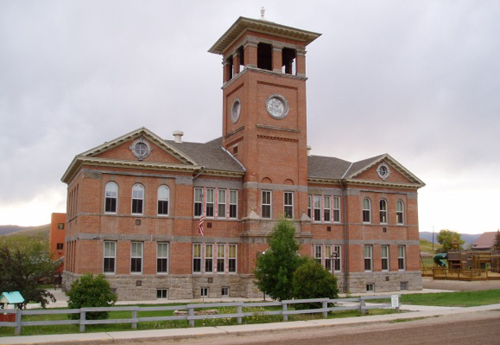
Philipsburg Grade School, originally a high school.
The "Prospector" logo is painted on the tower window.
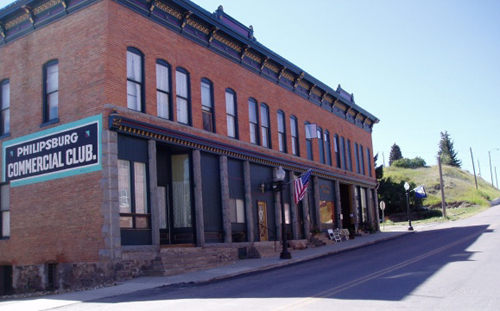
Opera House Theatre.
There are more photos of Philipsburg, modern and historic, available at Western Mining History.
In doing a routine follow-up of the Bureau of Land Management's partially implemented Land Patent search, I decided to scan for "Blouger," a common mistranscription of "Blonger," and turned up a previously undiscovered patent granted to Sam Blonger and one Bartholomew Coughlin on a claim outside of Leadville. We've never had the opportunity to investigate claims and patents in Leadville, where four of the Blonger brothers -- Lou, Sam, Simon, and Marvin -- briefly shared residence in the early 1880s. While Sam and Lou soon moved on to Albuquerque, Simon stayed behind as the superintendent of the Robert E. Lee mine. Marvin, the youngest of the brothers, also remained in Leadville for several years.
We've always suspected that the Blongers owned a mine in Leadville. In fact, there is a mine so named: the Blonger Mine, still listed as mindat.org. Jack Davidson found references to the Blonger Mine in the Denver Public Library. Meanwhile the encyclopedic History of Leadville and Lake County, Colorado indicated that there was a "Blonger lease" on the New Pittsburg or Big Pittsburg Mine, and we've never been able to determine whether this lease and the Blonger Mine were the same thing or something completely different.
The newly discovered patent is for the Hibernian (or Hibernia) Mine, right in the middle of all the activity of Fryer Hill, where the biggest strikes were made. In fact, it could easily be the Blonger Mine. The general location of the Hibernian (parts of Sections 19 and 24) given in the patent index, is consistent with the coordinates of the Blonger given in mindat.org, but more information is needed.
Even more interesting, if that is possible, is the date of the patent: April 15, 1882. Sound familiar? Sam and Lou were already in Albuquerque, serving as marshals and of course entertaining other business opportunities along the way. Meanwhile, Wyatt Earp and his posse were making their way out of Arizona to the relative safety of New Mexico. The Earps supposedly landed in Albuquerque on April 15 or 16 and, if the Otero Letter is to be believed, were soon under the care of "Blonger" -- some Blonger, either Sam or Lou.
Sam was in Albuquerque on the date the patent was granted. But both of the town's newspapers reported that Sam left for business in Denver on April 18. The Albuquerque Evening Review went further:
Marshal Sam Blonger goes to Denver to-morrow with samples of ore and maps of the Star mine in Hell canon. The Star now shows an eighteen foot vein of pay ore between walls, and the samples from it which Blonger will carry with him doubtless attract great attention in Denver.
Was Sam on his way to sell a mine, or to take care of his own mining business in Leadville? One thing is certain. He wasn't looking after Wyatt and the boys.
Several online sites list coordinates for the Hibernia Mine. It's about a quarter mile north of the location given for the Blonger Mine. The Hibernia appears to be at the bottom of Fryer Hill, near the road (E. 7th St.). One site with a series of old biographies mentions a man named Franklin T. Caley who bought a one-sixth interest in the Hibernia for $5,000 and cleared $50,000. If Sam played his cards right, he made a lot of money from the Hibernia.
A couple of years earlier, Joe was down in the Cerrillos Hills making the same kind of transactions. Information that Bill Baxter compiled and presented to us on our journey to New Mexico last year shows that Joe and his partner C. M. Purdin were very active in locating claims and dealing them in 1879 and 1880, at the start of the boom in the Hills. Blonger & Purdin located three claims -- the Agricultural, Purdin, and Vulture -- in August and September, 1879, and sold them as a package deal in December for $5,000. They sold a four-sixths interest in another mine, the Washington, for $5,000. And their original mine, the Union, packaged with a portion of the Independence, sold for $4,900.
As they say, that was a lot of money in those days.
|



